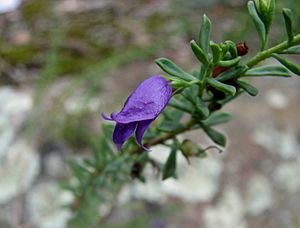Eremophila weldii facts for kids
Quick facts for kids Eremophila weldii |
|
|---|---|
 |
|
| Eremmophila weldii in Maranoa Gardens, Victoria | |
| Scientific classification | |
| Genus: |
Eremophila (plant)
|
| Species: |
weldii
|
| Synonyms | |
|
|
Eremophila weldii is a beautiful flowering plant that belongs to the figwort family, also known as Scrophulariaceae. This plant is special because it is endemic to Australia, meaning it naturally grows only there. It's a shrub with smooth, green leaves and pretty purple or lilac-coloured flowers. You can find Eremophila weldii growing in dry and semi-dry areas of Western Australia and South Australia.
Contents
What Eremophila weldii Looks Like
Eremophila weldii can grow in different ways. Sometimes it's an open, upright shrub that reaches about 1.5 m (5 ft) tall. Other times, it's a compact, low-growing prostrate shrub that is only about 15 cm (6 in) high but can spread up to 80 cm (30 in) wide.
Stems and Leaves
Its branches are smooth (which means glabrous). They are usually yellowish-green or green, sometimes with a touch of purple near the ends. Older, woody parts of the plant turn light brown. The leaves grow in an alternating pattern along the branches. Some leaves are scattered, while others grow in small groups near the branch tips.
The leaves are shaped like a spear or an egg, getting narrower towards the base. They are usually 2.5–10 mm (0.1–0.4 in) long and 1.5–3.5 mm (0.06–0.1 in) wide. Most of the leaves are smooth, except for a little bit of hair at their base. They are green or light green, sometimes with a purplish tint.
Flowers and Fruit
The flowers of Eremophila weldii grow one by one where the leaves meet the stem. Each flower sits on a smooth stalk that is about 2.5–6 mm (0.1–0.2 in) long.
Each flower has 5 overlapping sepals, which are small leaf-like parts that protect the bud. These sepals are egg-shaped or spear-shaped, sometimes with a purple color, and are 2.5–5 mm (0.1–0.2 in) long. They have tiny hairs on their inner surface.
The petals are 9–18 mm (0.4–0.7 in) long and are joined together at the bottom to form a tube. This petal tube is usually lilac or purple, often looking whitish underneath. The outside of the petal tube and its tips are mostly smooth. However, the lowest petal tip and the inside of the tube are covered with soft, woolly hairs.
Inside the flower, there are 4 stamens (the parts that produce pollen). These are usually hidden inside the petal tube, though two of them might be as long as the tube itself. Eremophila weldii flowers from March to December, usually after it rains. After flowering, the plant produces fruit. These fruits are oval or cone-shaped with a pointed end, about 3.5–4.5 mm (0.14–0.18 in) long, and have a hairy, wrinkled surface.
How it Got its Name
This plant was first officially described in 1870 by a famous botanist named Ferdinand von Mueller. He was the Victorian Government Botanist at the time. He wrote about it in the seventh book of his Fragmenta Phytographiae Australiae series.
Mueller's description was based on plant samples collected by John Forrest from places like Eucla and Point Dover. The second part of the plant's scientific name, weldii, was chosen to honor Frederick Aloysius Weld. He was the Governor of Western Australia when the plant was named.
Where Eremophila weldii Grows
You can find Eremophila weldii in several areas of South Australia, including the Nullarbor, Eyre Peninsula, and Kangaroo Island regions. It grows widely in soils that contain calcium carbonate (like limestone soils) and in red-brown earths.
In Western Australia, this plant grows on the Nullarbor Plain to the east of Balladonia. It can be found in several biogeographic regions, which are areas with similar plants and animals. These regions include Coolgardie, Hampton, Mallee, Murchison, and Nullarbor.
Is it Protected?
The Western Australian Government Department of Parks and Wildlife has classified Eremophila weldii as "not threatened." This means that the plant is not currently at risk of disappearing.
Growing Eremophila weldii in Your Garden
Eremophila weldii is known as one of the toughest Eremophila plants. It's a great choice for a garden that doesn't need a lot of care. It's also quite easy to grow new plants from cuttings, which you can take at any time of the year.
This shrub can grow in many different types of soil, even heavy clay. It rarely needs watering, even during long dry periods, and it can handle very cold temperatures (it's very frost tolerant).

